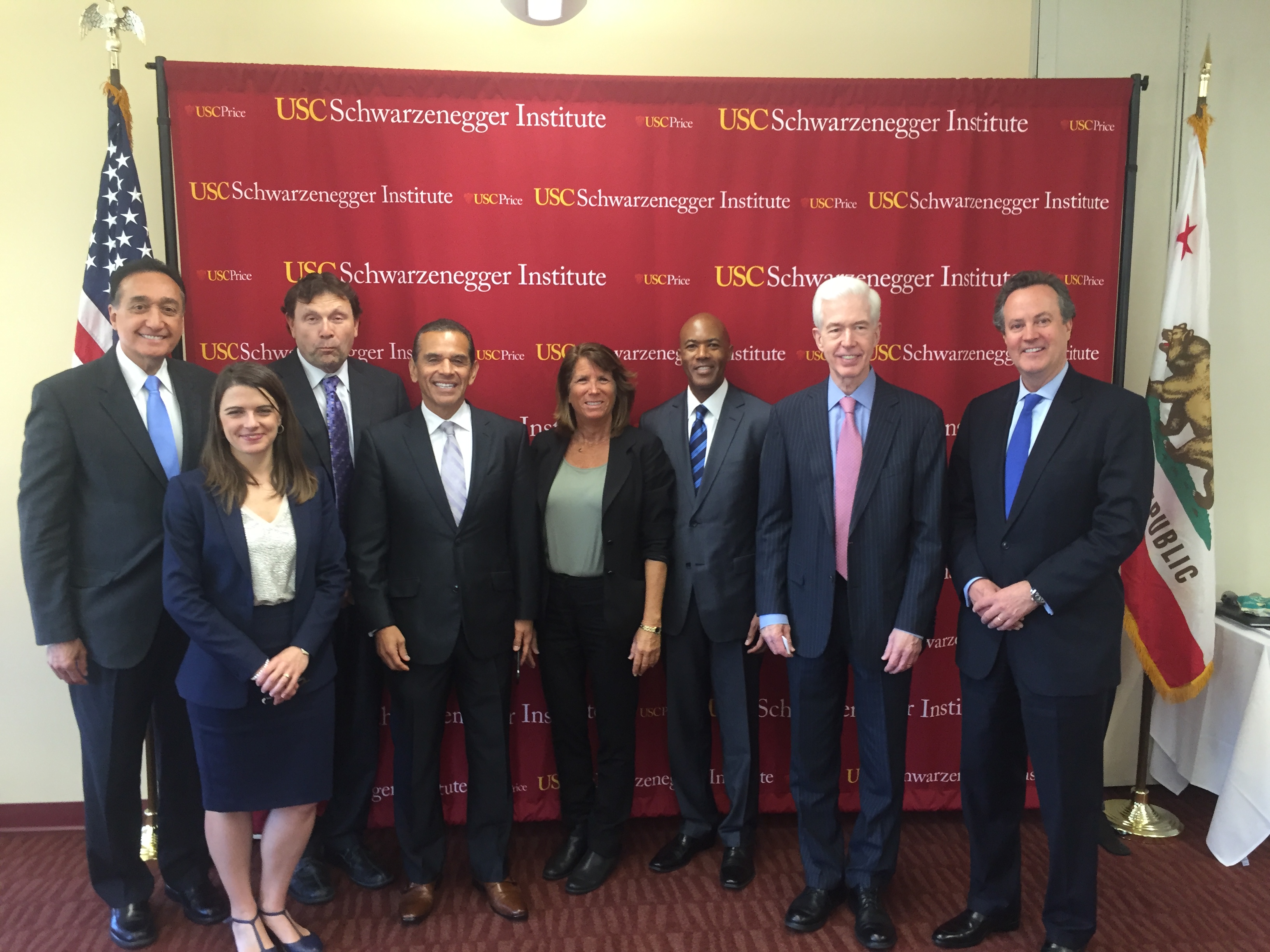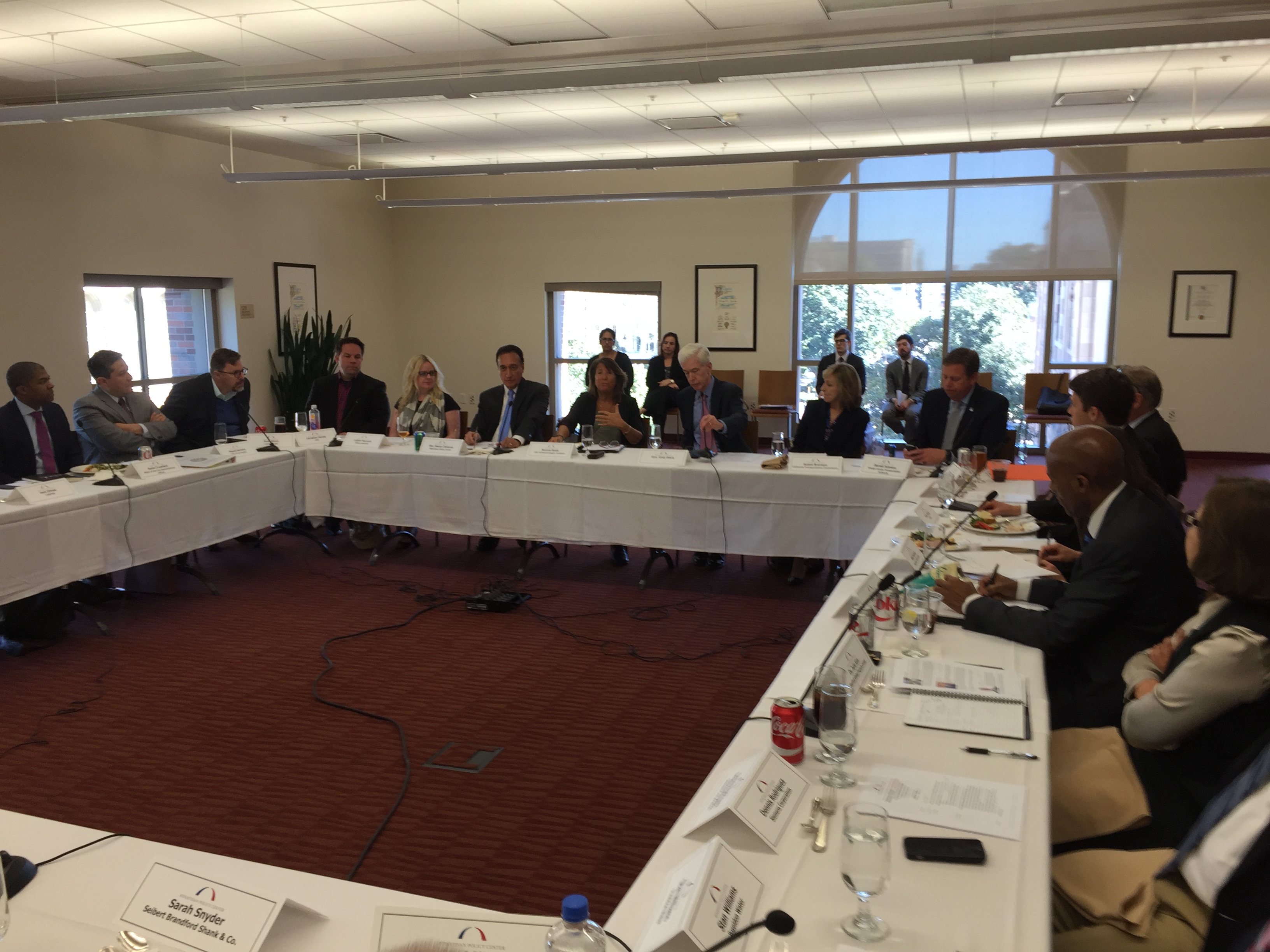INSTITUTE PARTNERS WITH THE BIPARTISAN POLICY CENTER TO DISCUSS THE UNITED STATES' INFRASTRUCTURE NEEDS
On February 16th the Institute hosted a forum with the Bipartisan Policy Center (BPC) to address the challenge of investing in, maintaining and building the roads, highways, bridges, schools, water projects, ports and transit systems desperately needed if the United States is going to remain competitive in the global marketplace.
Invited leaders included the head of the BPC’s Executive Council on Infrastructure chaired by Doug Peterson CEO of McGraw Hill Financial, local and state transportation and infrastructure leaders, as well as Governor Gray Davis, Mayor Antonio Villaraigosa, former HUD Secretary Henry Cisneros, CalSTRS CEO Jack Ehnes, CEO’s from Siemens, Edgemoor, Skanska, Poseidon Water, ARUP, Plenary Concessions, California Forward and the California Foundation on Environment and the Economy, and USC faculty.
Institute Global Director Bonnie Reiss provided some perspective on Schwarzenegger's commitment to the issue by highlighting the $41 billion infrastructure bond passed during his administration which leveraged another $200 billion in federal and private sector dollars. Reiss also expressed support for the great work of the Bipartisan Policy Center, and how putting people over politics is a hallmark of the Schwarzenegger Administration and of the Institute. Reiss mentioned how Schwarzenegger teamed up with Governor Ed Rendell of Pennsylvania and Mayor Michael Bloomberg of New York while in office to highlight the importance of investing in America’s infrastructure.
Doug Peterson explained that the BPC is traveling across America visiting innovative projects that utilize private public partnerships (P3). The BPC has also been meeting with regional leaders to learn what policies are needed to attract private capital and expertise. The BPC will issue a report in May that outlines what they have learned and makes recommendations for policy leaders in the United States.
Peterson explained that the U.S. only invests about 1.7% of our GDP in infrastructure while China invests 7% and most other nations invest 3-4% to highlight the important need for dramatically increased infrastructure spending.
Together the group explored the reasons behind this lack of investment as well as the resistance to P3 projects. It was mentioned that some public employee unions have been opposed to P3 projects and participants referenced the union efforts to stop the 405 highway expansion because 75 CalTrans jobs were at stake. Fortunately the thousands of jobs that would be created by the project persuaded the California Legislature to approve the project, but with a narrow margin of victory.
Everyone agreed that forming coalitions that include private sector unions especially from the building trades as well as local leaders who understand the benefits of the project to their community was critical to success. It was also agreed leaders need to better communicate the benefits of the projects they want to pass. Not only do infrastructure improvements create jobs they protect the environment by making travel more efficient and save workers valuable time during their daily commute.
Other suggestions that were made that will likely be included in the May report include:
– Establish consistent legal framework. Currently P3 projects are governed differently depending on city, state or region.
– Establish offices of expertise on local or state level to assist projects. In California currently there are billions of dollars in P3 projects including the 405, 710, 2 reservoirs, water projects and no guidance or expertise in any State agency. California is the 8th largest economy in the world but is considered by investors looking at infrastructure projects to have the risk of a developing nation.
– Make procurement process more consistent and less rigid to encourage private innovation.
– Reform California’s Environmental Quality Act permitting process and other permitting regulations which currently creates a costly and lengthy sequential permitting process. There is no objection to environmental and other review but all agree this can be much more streamlined.
– Greater transparency on the cost of both the building of projects and especially the maintenance over the life of project. The consensus was if this were properly communicated to the public they would have greater understanding of the risk to city or state government and taxpayers and be more supportive of P3’s.
The Institute is committed to continuing its partnership with the BPC and others working on this important policy issue. As CalSTRS’s Ehnes said, investors are not regionally loyal, but will invest their money where the risks are reduced and the investment climate is most attractive. It is important for the future of California that we understand how to attract these funds which can help build our schools, highways, bridges and other essential infrastructure.


